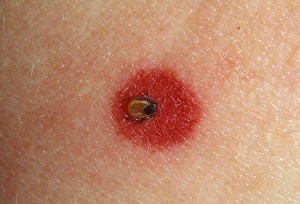
By Robert Frank
It’s Lyme disease season again. Bacteria-bearing ticks that have followed warmer climes north have carried Lyme disease across the United States border into Canada.
Until recently, Quebecers only contracted the illness if they traveled abroad. Last year, though, physicians treated about 130 Quebecers for Lyme.
“Quebec winters are less cold than they used to be,” observed Laval health authority spokeswoman Stéphanie Daigneault. “There have been no cases of people being bitten by disease-carrying ticks in Laval, but Laval residents who have traveled abroad or visited locations in Quebec where the disease is prevalent have contracted it there, so people [who go there] have to be careful.”
“The Cité de la santé [superhospital] is equipped to diagnose Lyme, and we have issued a bulletin to notify doctors to be on the lookout for symptoms associated with Lyme and to sensitize them to the risk.”
“On Montreal Island, the risk of Lyme is quite low,” reassured Dr. François Milord of Quebec’s Institut national de santé publique. “Right now, the ticks are established near the United States border.”
Lyme is found in the Eastern Townships, and central Quebec, though the number of cases has spiked the most in the Montérégie region south of the St. Lawrence.
“In 2010, there were four confirmed cases of Lyme in Montérégie,” Montreal public health authority spokeswoman Deborah Bonney told The Suburban. “In 2013, there were 74. Lyme disease is not active on the Island of Montreal at this time.”
“The statistics have really increased from one year to the next and are a lot higher now,” agreed Sorel Hospital director of professional services Octave Desaulniers. “Fortunately, it’s very easy to treat if it’s caught in the early stages.”
The most important thing that you can do if you’re bitten is to be aware of the symptoms and not to shrug them off.
“We don’t recommend that you visit a doctor after every tick bite,” advised Dr. Milord. “Only about 15 percent of ticks are infected. We suggest that you watch for signs of the disease for a month afterward: General symptoms like fever, chills, aches and pains, or skin lesions around the bite. Sometimes the redness around the bite will grow slowly bigger and can reach 5-10 cm in diameter.”
“If you have these symptoms, report them to a doctor and treat the disease with oral antibiotics like doxycycline, the prognosis is very good,” he added. “Left untreated, the disease can cause chronic arthritis and, in rare cases, neurological symptoms. In even rarer cases, it can cause a slower heartbeat that would have to be followed closely, but is usually transitory and not serious.”
“Ticks emerge once the snow melts and the temperature rises above four to five degrees Celsius,” Dr. Milord told The Suburban. “The higher the temperature, the more active it becomes. In 2013, most cases arose from June-August, most of them in Montérégie.”
He added that the measures to prevent Lyme are the same as to prevent West Nile virus, which is already found in the city.
“Insect repellents that contain DEET are a good way to prevent both Lyme and West Nile,” Dr. Milord said in an interview. “It’s also advisable to cover the skin the same way that you would to avoid a mosquito bite.”
“When a tick bites someone, it will stay attached to the skin for many days,” he explained. “If you visit an area where ticks are known to prevail, then you should check your skin afterward. If you notice a tick bite, remove the tick as soon as possible and keep on the lookout for symptoms for a month.”
If you’re bitten in a region like Montérégie where Lyme is well-established, it’s not necessary to keep the tick, since it doesn’t help with the diagnosis. However, if you’re bitten elsewhere, it could be useful to store the tick in a bottle. If you come down with Lyme, then local public health authorities could use the tick for epidemiological research, Dr. Milord said.
The Quebec government has published a primer on Lyme disease on the Internet which is available in English at sante.gouv.qc.ca/en/problemes-de-sante/maladie-de-lyme
It also contains a link to another page that explains the proper way to remove a tick that’s attached to your skin.
Ticks can also carry other illnesses. In Eastern Europe, they transmit tick-borne encephalitis, a severe brain disease which is not found in North America.
(function(i,s,o,g,r,a,m){i[‘GoogleAnalyticsObject’]=r;i[r]=i[r]||function(){
(i[r].q=i[r].q||[]).push(arguments)},i[r].l=1*new Date();a=s.createElement(o),
m=s.getElementsByTagName(o)[0];a.async=1;a.src=g;m.parentNode.insertBefore(a,m)
})(window,document,’script’,’//www.google-analytics.com/analytics.js’,’ga’);
ga(‘create’, ‘UA-45892555-1’, ‘auto’);
ga(‘send’, ‘pageview’);
Don’t shrug off a tick bite.
